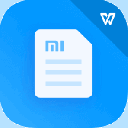


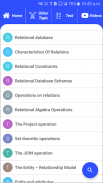

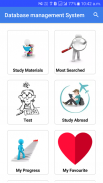
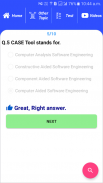

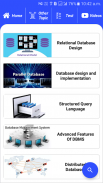
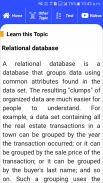
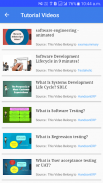
Database management system

Descrizione di Database management system
The app is a complete free handbook of Advance Database management system which covers important topics, notes, materials & news on the course. Download the App as a reference material & digital book for Computer science, software engineering programs & IT degree courses.
This useful App lists 130 topics with detailed notes, diagrams, equations, formulas & course material, the topics are listed in 10 chapters. The app is must have for all the engineering science students & professionals.
The app provides quick revision and reference to the important topics like a detailed flash card notes, it makes it easy & useful for the student or a professional to cover the course syllabus quickly just before an exams or job interviews.
Also get the hottest international engineering & technology news on your app powered by Google news feeds. We have customised it so that you get regular updates on subject from international/national colleges, universities, research, industry, applications, engineering, tech, articles & innovation.
This is the best application to remain updated on your fav. subject.
Use this useful engineering app as your education tool, utility, tutorial, book, a reference guide for syllabus and explore study course material, aptitude tests & project work.
Track your learning, set reminders, edit, add favourite topics, share the topics on social media.
Some of the topics Covered in this application are:
1. Parallel Database Architectures
2. Parallel Query Evaluation
3. Parallelising Individual Operations
4. Parallel Query Optimization
5. Introduction To Distributed Databases
6. Distributed DBMS Architectures
7. Storing Data in Distributed DBMS
8. Distributed Catalog Management
9. Updating Distributed Data
10. Distributed Concurrency Control
11. Distributed Recovery
12. Two-Phase Commit Revisited
13. Three-Phase Commit
14. Introduction To Data Mining
15. Counting Co-Occurences
16. Iceberg Queries
17. Mining for rules
18. Tree structured rules
19. Clustering problem
20. Clustering Algorithm
21. Data Mining Tasks
22. Similarity Search Over Sequences
23. Object-oriented database systems
24. New Data Types
25. Abstract data type
26. Methods of an ADT
27. Structured data types
28. Manipulating Data of Structured Types
29. Objects and Refrence Types
30. Inheritance
31. Design for an ORDBMS
32. Challeges in Implementing an ORDBMS
33. OODBMS
34. Object Query Language
35. Compare RDBMS with ORDBMS
36. Transaction Processing Monitors
37. New Transaction Models
38. Integrated access to multiple data sources
39. Mobile Databases
40. Main memory databases
41. Multimedia Database
42. Geographic Information Systems
43. Temporal and sequence databases
44. Information Visualization
45. OODBMS; Advantages & Disadvantages
46. Data warehouse
47. Contrasting OLTP and Data Warehousing Environments
48. Data warehouses architectures
49. Logical versus physical design in data warehouses
50. Data warehouse Schema
51. Data warehousing objects
52. Logical and Physical Design of data warehouse
53. Introduction To Data Mining
54. Data Mining Uses
55. Data Mining Functions
56. Data Mining Technologies
57. Emerging Database Models
58. Multimedia Database
59. Temporal Databases
60. Designing Temporal Databases
61. Logical design of temporal databases
62. Conceptual design of temporal databases
63. Temporal databases implementation
64. Temporal DBMS implementation
65. Implementing Algebraic Operators Page
Each topic is complete with diagrams, equations and other forms of graphical representations for better learning and quick understanding.
Advance Database management system is part of engineering education courses and technology degree programs
of various universities.</br></br></br></br></br></br></br></br></br></br></br></br></br></br></br></br></br></br></br></br></br></br></br></br></br></br></br></br></br></br></br></br></br></br></br></br></br></br></br></br></br></br></br></br></br></br></br></br></br></br></br></br></br></br></br></br></br></br></br></br></br></br></br></br></br></br></br></br></br></br></br></br></br></br></br></br></br></br></br></br></br></br></br></br>
















